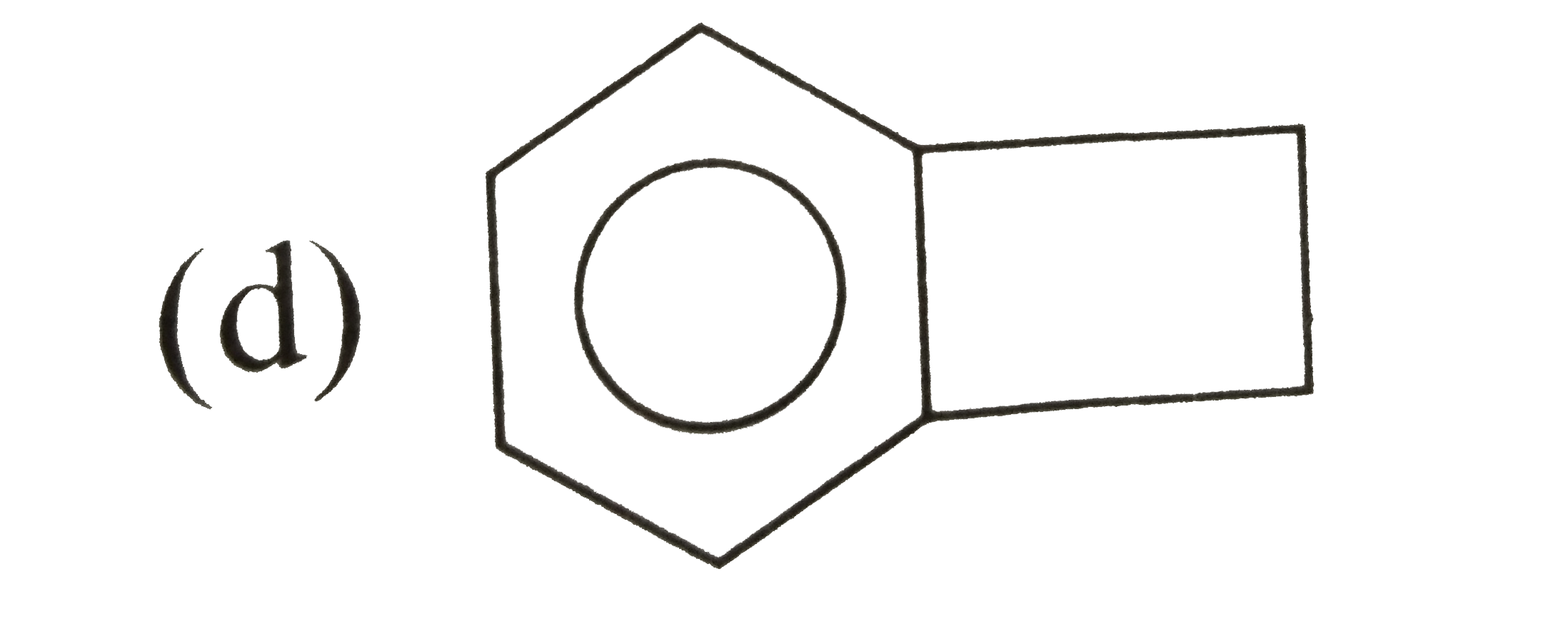Aromatic hydrocarbon can show electrophilic substitution reaction, oxidation and acidic nature. If alkyl group attached to benzene ring has α−H atom, it is oxidiesd into-COOH group. The electrophilic sustittion in aromatic compounds takes The at the position where most stable σ complex is formed :

the product formed is/are:




The correct Answer is:b
Step by step video, text & image solution for Aromatic hydrocarbon can show electrophilic substitution reaction, oxidation and acidic nature. If alkyl group attached to benzene ring has alpha-H atom, it is oxidiesd into-COOH group. The electrophilic sustittion in aromatic compounds takes The at the position where most stable sigma complex is formed : the product formed is/are: by Chemistry experts to help you in doubts & scoring excellent marks in Class 11 exams.
Updated on:21/07/2023Similar Questions
Aromatic hydrocarbons are highly unsaturated molecules but behave like saturated hydrocarbons. Those which contain a benzene ring are called benzenoids but those which contain some highly unsaturated ring other than benzene are called non-benzenoids. Their aromatic character can be ascertained through Hückel rule. Aromatic hydrocarbons are, however, more reactive than alkanes but are less reactive than alkenes and alkynes. The lower reactivity of arenes is because of the extra stability associated with these molecules due to delocalization of -electrons. Their stability is measured in terms of resonance energy which can be estimated from either heat of combustion or heat of hydrogenation data. They normally undergo electrophilic substitution reactions. In presence of a Lewis acid catalyst, nuclear halogenation occurs but in absence of Lewis acid catalyst and in presence of light, halogens add to the benzene ring. If an aromatic hydrocarbon contains an alkyl side chain, then in presence of heat/light side chain halogenation occurs in preference to addition of halogens to the benzene ring. The reactivity of aromatic hydrocarbons towards electrophilic substitution reactions depends upon the electron density in the benzene ring. Electron-donating groups favour while electron-withdrawing groups retard these reactions. Orientation of electrophilic substitution reactions is governed by the nature of the substituent already present in the ring. Although aromatic hydrocarbons are resistant to oxidising agents (KMnO4,K2Cr2O7, etc.) they do undergo ozonolysis.
Reaction of benzene with excess of Cl2 in presence of light and in presence of anhydrous AlCl3 and in dark give respectively
View SolutionAromatic hydrocarbons are highly unsaturated molecules but behave like saturated hydrocarbons. Those which contain a benzene ring are called benzenoids but those which contain some highly unsaturated ring other than benzene are called non-benzenoids. Their aromatic character can be ascertained through Hückel rule. Aromatic hydrocarbons are, however, more reactive than alkanes but are less reactive than alkenes and alkynes. The lower reactivity of arenes is because of the extra stability associated with these molecules due to delocalization of -electrons. Their stability is measured in terms of resonance energy which can be estimated from either heat of combustion or heat of hydrogenation data. They normally undergo electrophilic substitution reactions. In presence of a Lewis acid catalyst, nuclear halogenation occurs but in absence of Lewis acid catalyst and in presence of light, halogens add to the benzene ring. If an aromatic hydrocarbon contains an alkyl side chain, then in presence of heat/light side chain halogenation occurs in preference to addition of halogens to the benzene ring. The reactivity of aromatic hydrocarbons towards electrophilic substitution reactions depends upon the electron density in the benzene ring. Electron-donating groups favour while electron-withdrawing groups retard these reactions. Orientation of electrophilic substitution reactions is governed by the nature of the substituent already present in the ring. Although aromatic hydrocarbons are resistant to oxidising agents (KMnO4,K2Cr2O7, etc.) they do undergo ozonolysis.
The enthalpy of hydrogenation of cyclohexene is −119.5kJ mol−1.If resonance energy of benzene is −150.4kJ mol−1, its enthalpy of hydrogenation would be
View Solution
Knowledge Check
Aromatic hydrocarbon can show electrophilic substitution reaction, oxidation and acidic nature. If alkyl group attached to benzene ring has α−H atom, it is oxidiesd into-COOH group. The electrophilic sustittion in aromatic compounds takes The at the position where most stable σ complex is formed :
Answer the following questions :

out of the given compounds 'A' is/are:A B
B C
C D
D
Aromatic hydrocarbons are highly unsaturated molecules but behave like saturated hydrocarbons. Those which contain a benzene ring are called benzenoids but those which contain some highly unsaturated ring other than benzene are called non-benzenoids. Their aromatic character can be ascertained through Hückel rule. Aromatic hydrocarbons are, however, more reactive than alkanes but are less reactive than alkenes and alkynes. The lower reactivity of arenes is because of the extra stability associated with these molecules due to delocalization of -electrons. Their stability is measured in terms of resonance energy which can be estimated from either heat of combustion or heat of hydrogenation data. They normally undergo electrophilic substitution reactions. In presence of a Lewis acid catalyst, nuclear halogenation occurs but in absence of Lewis acid catalyst and in presence of light, halogens add to the benzene ring. If an aromatic hydrocarbon contains an alkyl side chain, then in presence of heat/light side chain halogenation occurs in preference to addition of halogens to the benzene ring. The reactivity of aromatic hydrocarbons towards electrophilic substitution reactions depends upon the electron density in the benzene ring. Electron-donating groups favour while electron-withdrawing groups retard these reactions. Orientation of electrophilic substitution reactions is governed by the nature of the substituent already present in the ring. Although aromatic hydrocarbons are resistant to oxidising agents (KMnO4,K2Cr2O7, etc.) they do undergo ozonolysis.
In the reaction of C6H5Y, the major product ( gt 60%) is m-isomer , so the group Y isA−COOHB−ClC−OHD−NH2Aromatic hydrocarbons are highly unsaturated molecules but behave like saturated hydrocarbons. Those which contain a benzene ring are called benzenoids but those which contain some highly unsaturated ring other than benzene are called non-benzenoids. Their aromatic character can be ascertained through Hückel rule. Aromatic hydrocarbons are, however, more reactive than alkanes but are less reactive than alkenes and alkynes. The lower reactivity of arenes is because of the extra stability associated with these molecules due to delocalization of -electrons. Their stability is measured in terms of resonance energy which can be estimated from either heat of combustion or heat of hydrogenation data. They normally undergo electrophilic substitution reactions. In presence of a Lewis acid catalyst, nuclear halogenation occurs but in absence of Lewis acid catalyst and in presence of light, halogens add to the benzene ring. If an aromatic hydrocarbon contains an alkyl side chain, then in presence of heat/light side chain halogenation occurs in preference to addition of halogens to the benzene ring. The reactivity of aromatic hydrocarbons towards electrophilic substitution reactions depends upon the electron density in the benzene ring. Electron-donating groups favour while electron-withdrawing groups retard these reactions. Orientation of electrophilic substitution reactions is governed by the nature of the substituent already present in the ring. Although aromatic hydrocarbons are resistant to oxidising agents (KMnO4,K2Cr2O7, etc.) they do undergo ozonolysis.
Which of the following is not a non-benzenoid aromatic compound ?ATropylium cationBAzuleneCTropoloneDDiphenyl
The amino group when attached to the ring makes it highly activating towards electrophilic substitution. Consequently, the electrophilic substitution readily takes place in aniline at all the three ortho and para positions. However on acetylation with acetyl chloride the activation of the ring to amino group is sufficiently reduced and the electrophilic substitution in benzene ring takes place preferably at the para position which is less hindered than the ortho position.
Towards electrophilic substitution, most reactive will be
View SolutionThe typical reaction of benzene and other aromatic compounds are electrophilic substitution. Presence of electron donating group activates the ring towards electrophilic substitution, while presence of electron withdrawing group deactivates the ring towards electrophilic substituion but at the same time activates the ring towards nucleophilic subsituion. Some groups are predominantly meta-directing and all of these are deactivating. Except halogen, most of the o−andp−directing groups are activating groups.
Which of the following compound is not formed.
_E01_248_Q01.png) (i)NBS,CCl4,hv−−−−−−−−−−−→(II)Br2/FeBr3(X)
(i)NBS,CCl4,hv−−−−−−−−−−−→(II)Br2/FeBr3(X)
X represents mixture of organic compounds. The mixture does not contain
View SolutionThe amino group when attached to the ring makes it highly activating towards electrophilic substitution. Consequently, the electrophilic substitution readily takes place in aniline at all the three ortho and para positions. However on acetylation with acetyl chloride the activation of the ring to amino group is sufficiently reduced and the electrophilic substitution in benzene ring takes place preferably at the para position which is less hindered than the ortho position.
3, 5 dibromotolyene can be best synthesised by
View SolutionThe typical reaction of benzene and other aromatic compounds are electrophilic substitution. Presence of electron donating group activates the ring towards electrophilic substitution, while presence of electron withdrawing group deactivates the ring towards electrophilic substituion but at the same time activates the ring towards nucleophilic subsituion. Some groups are predominantly meta-directing and all of these are deactivating. Except halogen, most of the o−andp−directing groups are activating groups.
_E01_246_Q01.png) C2H5Cl.AlCl3−−−−−−−−→Δ(A) major.
C2H5Cl.AlCl3−−−−−−−−→Δ(A) major.
A is trisubstituted benzene. The structure of A is :
View SolutionThe amino group when attached to the ring makes it highly activating towards electrophilic substitution. Consequently, the electrophilic substitution readily takes place in aniline at all the three ortho and para positions. However on acetylation with acetyl chloride the activation of the ring to amino group is sufficiently reduced and the electrophilic substitution in benzene ring takes place preferably at the para position which is less hindered than the ortho position.
Which of the following reagent is used to distinguish between

View Solution
